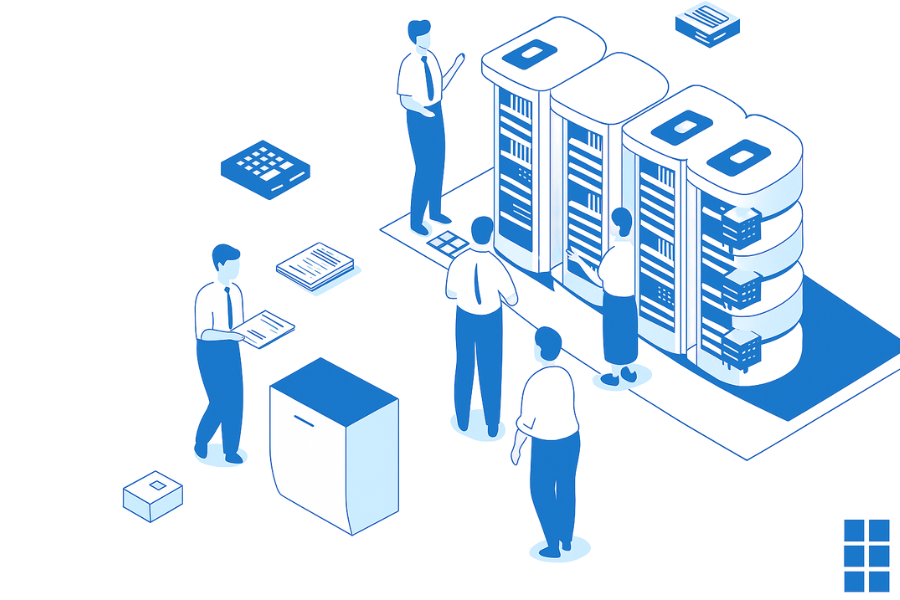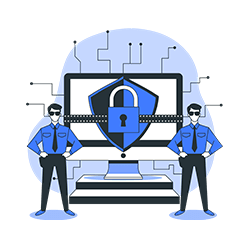
DCIM data center, IT infrastructure monitoring, and data center operations have become critical pillars of modern digital strategy. With rising workloads, expanding hybrid cloud environments, and increasing application complexity, IT teams can no longer rely on manual oversight or reactive problem-solving. They need systems that provide visibility, predictability, and control — and this is exactly what Data Center Infrastructure Management (DCIM) delivers.
DCIM gives businesses the ability to track operations in real time, anticipate failures before they happen, optimize power usage, and run their infrastructure far more efficiently. Whether you manage servers in your own data center, use colocation services, or deploy dedicated hardware inside environments like NexonHost’s European data centers, DCIM is the invisible engine that ensures uptime, reliability, and operational excellence.
Let’s explore what DCIM truly is, how it works, and why it is now indispensable for modern organizations.
What Is Data Center Infrastructure Management (DCIM)?
DCIM is a comprehensive framework that merges facility management, IT management, and intelligent automation into a single operational ecosystem. It is designed to provide complete oversight of every physical and logical component inside a data center — from power distribution units and cooling systems to servers, networking gear, and environmental sensors.
DCIM replaces outdated, manual oversight methods with a unified system that shows how all components are functioning at any given moment. It provides real-time data, historical trends, predictive insights, capacity forecasts, and automated alerts — enabling data centers to operate with precision and reliability.
DCIM is not simply a monitoring tool; it is an operational strategy that transforms data centers into predictable, optimized, and highly resilient environments.
Why DCIM Matters More Today Than Ever
1. Growing Complexity of Data Center Operations
Today’s data centers handle more responsibilities than ever before. Hybrid architectures combine public cloud, private cloud, colocation, and bare-metal deployments. Workloads now include virtualization, containerization, AI workloads, HPC clusters, streaming services, and large-scale SaaS operations.
Managing these environments manually would lead to inefficiencies, downtime, and resource wastage. DCIM brings order to this complexity by automating monitoring, consolidating insights, and ensuring teams always know precisely what is happening inside their infrastructure. For businesses using high-capacity dedicated servers from NexonHost, DCIM helps ensure every system is optimized, cooled correctly, and performing at peak efficiency.
2. Pressure to Ensure Zero Downtime
In a world where digital platforms operate 24/7, downtime is no longer a technical issue — it is a business threat. Every minute of downtime can result in thousands or even millions of dollars in lost revenue, SLA violations, damaged reputation, and customer churn.
DCIM minimizes downtime by delivering early-warning alerts, predictive maintenance insights, and automated responses to abnormal behavior. It reduces the risk of power failures, cooling breakdowns, overloaded servers, and network bottlenecks. This makes DCIM essential for businesses hosting mission-critical applications inside NexonHost data centers, where uptime and reliability are paramount.
3. Rising Energy Costs & Sustainability Requirements
Data centers consume enormous amounts of energy. Cooling systems, power distribution, and high-density hardware all contribute to rising operational expenses. Sustainability mandates from governments and corporate ESG guidelines put additional pressure on operators to remain energy efficient.
DCIM optimizes power usage, identifies inefficient cooling zones, recommends load distribution patterns, and ensures that resources are not being wasted. This lowers operational costs and helps data centers meet environmental compliance requirements. For companies deployed on NexonHost’s infrastructure, DCIM ensures their servers operate in an energy-efficient and sustainable environment.
How DCIM Works: Deep-Dive Into Core Capabilities
1. Asset Management & Infrastructure Mapping
DCIM creates a live, visual map of the entire data center. This includes racks, servers, switches, cabling, power systems, cooling equipment, and even airflow patterns.
Instead of relying on spreadsheets or memory, IT teams can access real-time views of asset locations, configurations, and statuses. This prevents resource misallocation, helps identify underutilized assets, and improves planning for new deployments. Companies using NexonHost’s dedicated servers benefit from this clarity because they can manage their hardware footprint efficiently and accurately.
2. IT Infrastructure Monitoring
Monitoring is the heartbeat of DCIM. It constantly tracks server usage (CPU, RAM, disk I/O), power draw, network throughput, temperature, humidity, and system performance across all racks and devices.
Instead of discovering issues after they cause downtime, DCIM warns teams when thresholds are crossed — whether it’s rising temperatures, overloaded power circuits, or increasing latency. This kind of proactive monitoring is invaluable for businesses running high-performance workloads on NexonHost’s dedicated servers.
3. Environmental Monitoring & Alerts
Environmental failures — not hardware defects — cause a significant portion of data center outages. DCIM installs sensors throughout the facility to measure temperature fluctuations, humidity spikes, airflow irregularities, water leaks, and electrical anomalies.
If any environmental variable enters a danger zone, DCIM instantly alerts the operations team or triggers automated responses. This helps prevent fires, heat buildup, cooling failures, and environmental hazards.
4. Capacity Planning & Forecasting
DCIM does not just show what is happening now — it predicts what will happen next. Capacity planning tools analyze current utilization trends to determine when additional power, cooling, or racks will be needed.
These forecasts help businesses avoid over-provisioning or running out of capacity at a critical moment. Organizations scaling their infrastructure on NexonHost use DCIM-driven insights to determine when to deploy more servers or redistribute workloads.
5. Automation & Workflow Orchestration
Automation is a major advantage of DCIM. The system can automatically balance power loads, adjust cooling output, reroute traffic, or shift workloads between servers to prevent failures.
Workflows can also automate maintenance tasks, generate reports, and escalate issues when thresholds are crossed. This reduces manual labor, cuts operational costs, and improves overall reliability.
6. Security & Access Controls
DCIM contributes to physical and logical security. It tracks who enters the facility, which racks they access, and what changes they make. Rack-level sensors, biometric systems, and access logs ensure unauthorized actions are detected and prevented.
This level of security is essential for organizations hosting sensitive workloads such as financial systems or medical data. Natively secure environments like NexonHost’s data centers leverage DCIM systems to meet security compliance standards.
Business Benefits of DCIM: Why Decision-Makers Should Care
1. Improved Uptime Through Proactive Prevention
Downtime affects revenue, customer trust, and brand reputation. DCIM helps prevent outages by detecting thermal issues, power anomalies, component degradation, and bottlenecks before they escalate. This ensures continuity for businesses hosting mission-critical applications.
2. Reduced Operational Costs
Energy efficiency is one of the largest cost-saving areas for data centers. DCIM identifies cooling inefficiencies, helps eliminate stranded power, minimizes over-provisioned resources, and reduces unnecessary hardware usage. The result is a lower total cost of ownership (TCO) and more optimized spending.
3. Enhanced Team Productivity
DCIM eliminates guesswork, reduces manual oversight, and centralizes monitoring under a unified dashboard. IT teams spend less time diagnosing issues and more time optimizing infrastructure strategy. DCIM enables remote operations, cross-team collaboration, and faster troubleshooting.
4. Higher Security & Regulatory Compliance
DCIM’s audit trails, access logs, environmental data, and monitoring insights support compliance with GDPR, ISO 27001, PCI-DSS, and similar frameworks. Organizations hosting sensitive workloads rely on DCIM to meet required security, privacy, and operational integrity standards.
5. Sustainable, Scalable Infrastructure Growth
With accurate real-time and historical data, DCIM enables smarter scaling decisions. It guides where to place new servers, how to distribute power loads, and when to expand or consolidate infrastructure. This leads to long-term sustainability and predictable growth.
DCIM Use Cases: Where It Makes the Biggest Impact
Cloud Hosting Providers
Companies like NexonHost rely heavily on DCIM to manage thousands of servers across multiple regions. DCIM ensures predictable performance, safe thermal conditions, and efficient resource allocation.
Enterprises Running on Dedicated Hardware
Businesses with bare-metal servers require precise monitoring to ensure workloads run smoothly. DCIM provides the visibility needed to optimize server health, cooling efficiency, and power distribution.
Colocation & Hybrid Cloud Environments
DCIM helps enterprises manage distributed infrastructure across the cloud, edge facilities, and colocation centers.
AI & High-Performance Computing (HPC)
High-density workloads create unique challenges in heat, power, and cooling. DCIM ensures these environments remain safe, stable, and efficient.
Fintech, Healthcare & Regulated Industries
DCIM provides the monitoring, logging, and compliance capabilities required for mission-critical regulatory frameworks.
Why DCIM Is Crucial for NexonHost Customers
Whether you deploy:
- dedicated servers
- bare-metal clusters
- hybrid cloud workloads
- colocation equipment
DCIM supports the underlying operations that keep your systems performing at peak capacity. NexonHost uses advanced monitoring and infrastructure intelligence to ensure every server operates with maximum reliability, optimal cooling, and stable power distribution.
FAQs
1. What is DCIM used for in a data center?
DCIM is used to monitor, manage, and optimize data center power, cooling, assets, server health, and environmental conditions, ensuring smooth operations and preventing downtime.
2. How does DCIM improve IT infrastructure monitoring?
DCIM provides real-time visibility into physical and digital infrastructure performance, helping teams detect issues early, automate alerts, and maintain high uptime.
3. Why is DCIM important for data center operations?
DCIM reduces energy costs, increases efficiency, enhances cooling performance, improves scalability, and minimizes downtime risk — making operations predictable and resilient.
4. Does DCIM integrate with dedicated servers?
Yes. DCIM works seamlessly with dedicated and bare-metal servers by monitoring their thermal load, power usage, resource consumption, and overall health.
5. How can I get infrastructure with strong monitoring support?
You can deploy high-performance dedicated servers with built-in monitoring through NexonHost Dedicated Servers or contact the team for guidance at Contact Us.


Leave a Reply